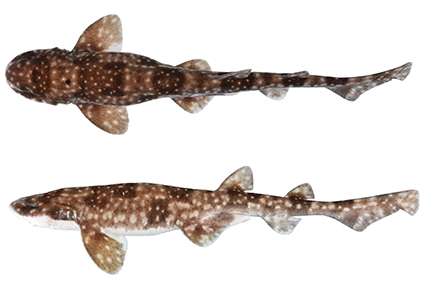Abstract
A new species of catshark genus Scyliorhinus, S. hachijoensis sp. nov., is described for the islands of Mikurajima, Hachijojima, and Torishima in southeastern Japan. Scyliorhinus hachijoensis has clasper hooks, which is a common feature in males of the most closely related species (S. torazame), but is distinguished by its coloration (presence of dark spots), the height of its anal fin (higher than the caudal peduncle), and the shape of pectoral and pelvic fins, and dermal denticles. Molecular data also corroborates the new species as a distinct and monophyletic taxon by nucleotide sequence analysis of three mitochondrial DNA regions.
References
Bustamante, C., Kyne, P. M. & Bennett, M.B. (2013) Comparative morphology of the egg cases of Asymbolus analis, Asymbolus rubiginosus and Figaro boardmani (Carcharhiniformes: Scyliorhinidae) from southern Queensland, Australia. Journal of Fish Biology, 83, 133–143. https://doi.org/10.1111/jfb.12155
Carpenter, K.E. (1998) FAO species identification guide for fishery purposes. The living marine resources of the Western Central Pacific. Vol. 2. Cephalopods, crustaceans, holothurians and sharks. FAO, Rome, 710 pp. [pp. 687–1396]
Compagno, L.J.V. (1984) FAO species catalogue. Vol. 4. Sharks of the World: An annotated and illustrated catalogue of shark species known to date. Part 2. Carcharhiniformes. FAO Fisheries Synopsis, 125 (4), 251–655.
Compagno, L.J.V. (1988) Sharks of the Order Carcharhiniformes. Princeton University Press, Princeton, New Jersey, 542 pp.
Compagno, L.J.V. (2001) Shark of the world. An annotated and illustrated catalogue of sharks known to date. Vol. 2. Bullhead, mackerel and carpet sharks (Heterodontiformes, Lamniformes and Orectolobiformes). FAO species catalogue for fishery purposes, Rome, 269 pp.
Diepenbroek, M., Grobe, H. & Sieger, R. (2000) PanMap. Available from: http://www.pangaea.de/Software/PanMap (accessed 29 December 2021)
Dyldin, Y.V. (2015) Annotated checklist of the sharks, batoids and chimaeras (Chondrichthyes: Elasmobranchii, Holocephali) from waters of Russia and adjacent areas. Publications of the Seto Marine Biological Laboratory, 43, 40–91. https://doi.org/10.5134/197957
Ebert, D.A., Fowler, S. & Compagno, L. (2013a) Sharks of the World: A Fully Illustrated Guide. Wild Nature Press, Plymouth, 528 pp.
Ebert, D.A., White, W.T., Ho, H.-C., Last, P.R., Nakaya, K., Séret, B., Straube, N., Naylor, G.J.P. & de Carvalho, M.R. (2013b) An annotated checklist of the chondrichthyans of Taiwan. Zootaxa, 3752 (1), 279–386. https://doi.org/10.11646/zootaxa.3752.1.17
Fricke, R. & Eschmeyer, W.E. (2020) A guide to fish collections in the Catalog of Fishes. Online Version 7 December 2020. Available from: http://researcharchive.calacademy.org/research/ichthyology/catalog/collections.asp (Accessed 7 Dec. 2020)
Hagiwara, S. (1993) Keeping and Reproduction of Chondrichthyans in Captivity at Shimoda Floating Aquarium. Report of Japanese Society for Elasmobranch Studies, 30, 1–18.
Herman, J., Hovestadt-Euler, M. & Hovestadt, D.C. (1993) Contributions to the study of the comparative morphology of teeth and other relevant ichthyodorulites in living supraspecific taxa of Chondrichthyan fishes. Part A: Selachii. No. 2b: Order: Carcharhiniformes—Family: Scyliorhinidae. Bulletin de l’institut Royal des Sciences Naturalles de Belgique, Biology, 60, 181–230.
Ivanova, N.V., Zemlak, T.S., Hanner, R.H. & Hebert, P.D.N. (2007) Universal primer cocktails for fish DNA barcoding. Molecular Ecology Notes, 7, 544–548. https://doi.org/10.1111/j.1471-8286.2007.01748.x
Kim, B.J., Kim, I.S., Nakaya, K., Yabe, M., Cho, Y. & Imamura, H. (2009) Checklist of the Fishes from Jeju Island, Korea. Bulletin of the Faculty of Fisheries Hokkaido University, 59 (1), 7–36.
Kumar, S., Stecher, G., Li, M., Knyaz, C., & Tamura, K. (2018) MEGA X: Molecular Evolutionary Genetics Analysis across computing platforms. Molecular Biology and Evolution, 35, 1547–1549. https://doi.org/10.1093/molbev/msy096
Nakaya, K. (1975) Taxonomy, Comparative Anatomy and Phylogeny of Japanese Catsharks, Scyliorhinidae. Memories of the Faculty of Fisheries, Hokkaido University, 23 (1), 1–94.
Pietschmann, V. (1906) Ichthyologische Ergebnisse einer Reisen ach Island, an die atlantische Küste von Marokko und in die westliche Hälfte des Mittelmeeres. Annalen des Naturhistorischen Museums in Wien, 21, 72–148.
Pietschmann, V. (1908) Zwei neue japanische Haifische. Anzeiger der Akademie der Wissenschaften in Wien, 45 (10), 132–135.
Shirai, S., Hagiwara, S. & Nakaya, K. (1992) Scyliorhinus tokubee sp. nov. from Izu Peninsula, Southern Japan (Scyliorhinidae, Elasmobranchii). Japanese Journal of Ichthyology, 39 (1), 9–16. https://doi.org/10.11369/jji1950.39.9
Soares, K.D.A. (2020) Comparative anatomy of the clasper of catsharks and its phylogenetic implications (Chondrichthyes: Carcharhiniformes: Scyliorhinidae). Journal of Morphology, 281, 591–607. https://doi.org/10.1002/jmor.21123
Soares, K.D.A. & de Carvalho, M.R. (2019) The catshark genus Scyliorhinus (Chondrichthyes: Carcharhiniformes: Scyliorhinidae): taxonomy, morphology and distribution. Zootaxa, 4601 (1), 1–147. https://doi.org/10.11646/zootaxa.4601.1.1
Soares, K.D.A. & de Carvalho, M.R. (2020) Phylogenetic relationships of catshark species of the genus Scyliorhinus (Chondrichthyes, Carcharhiniformes, Scyliorhinidae) based on comparative morphology. Zoosystematics and Evolution, 96 (2), 345–395. https://doi.org/10.3897/zse.96.52420
Soares, K.D.A., Gadig, O.F.B. & Gomes, U.L. (2015) Scyliorhinus ugoi, a new species of catshark from Brazil (Chondrichthyes: Carcharhiniformes: Scyliorhinidae). Zootaxa, 3937 (2), 347–361. https://doi.org/10.11646/zootaxa.3937.2.6
Springer, S. (1979) A revision of the catsharks, family Scyliorhinidae. NOAA technical report NMFS circular, 422, 1–97. https://doi.org/10.5962/bhl.title.63029
Springer, V.G. (1964) A revision of the Carcharhinid shark genera Scoliodon, Loxodon, and Rhizoprionodon. Proceedings of the United States National Museum, 115 (3493), 559–632. https://doi.org/10.5479/si.00963801.115-3493.559
Tamura, K. & Nei, M. (1993) Estimation of the number of nucleotide substitutions in the control region of mitochondrial DNA in humans and chimpanzees. Molecular Biology and Evolution, 10, 512–526.
Weigmann, S. (2016) Annotated checklist of the living sharks, batoids and chimaeras (Chondrichthyes) of the world, with a focus on biogeographical diversity. Journal of Fish Biology, 88 (3), 837–1037. https://doi.org/10.1111/jfb.12874


